|
Subscribe / Renew |
|
|
Contact Us |
|
| ► Subscribe to our Free Weekly Newsletter | |
| home | Welcome, sign in or click here to subscribe. | login |
Real Estate
| |
 |
February 23, 2017
Endless job growth fuels robust multifamily market
JLL

Young
|
Nonstop job creation and unprecedented single-family home prices are key factors driving Seattle’s thriving multifamily market.
In September 2016, Seattle topped the nation in home price growth with an 11 percent increase over the year prior. Meanwhile, leading tech companies such as Amazon and Google have contributed to the creation of jobs at a rate of roughly 61,000 per year since 2010. This means an increase in the number of renters in Seattle, many of whom are tech employees who can afford higher rental rates in new construction apartment buildings.
Seattle’s evolution from a secondary market to a top tech destination has created remarkably high demand and ensures a bright future for the city, with multifamily development expected to continue.
Here are some highlights for Seattle:
• Investor interest in core locations remains strong
• Alaska Way Viaduct tunneling 85 percent complete, projected opening 2019
• Seattle tops the nation in single-family home price growth for the first time in nine years with 11 percent year over year growth
• Home values have increased nearly 60 percent since early 2012
• $54 billion ST3 plan adds 62 new miles of light rail by 2036
• Seattle condominium development starting; 1,012 units under construction with 75 percent in downtown core

• International investment increasing; $752 million in Seattle/Bellevue since 2011
• Fourth fastest growing city in the nation
• Multifamily experiences record-breaking sales in 2016, with volume exceeding $5 billion for the first time
• Interest in suburban locations has picked up dramatically as investors look for affordable rental assets
Demand
The rate of job creation is projected to continue as Seattle establishes itself as a primary market for out-of-state companies seeking lower office rents and proximity to Seattle’s growing pool of tech talent. Washington was recently voted the third most innovative economy in the country and leads the nation for technology/STEM growth.
NerdWallet ranked Seattle as the second-best place for STEM graduates, and it has the highest salaries for software engineers of any city in the nation.
The flight to affordability is also leading to increased interest in Seattle’s suburban markets while higher incomes, especially in the specialized fields of high-tech and bio-tech, allow landlords to raise rental rates when leases renew. However, even as rents in new construction buildings reach record highs in Seattle, they are still perceived as relatively inexpensive compared to other cities such as San Francisco.
In San Francisco, the median tech salary is only slightly higher than Seattle’s: $110,554 versus $108,240. But figure in California’s income tax and the yearly cost of a one-bedroom high-rise apartment — $50,400 in San Francisco versus $33,600 in Seattle — and Seattle workers have nearly double the disposable income as Bay Area workers.
Home values in Seattle increased by nearly 60 percent between early 2012 and 2016, and in 2016 a record-low 1,600 homes went on the market in King County (7,400 homes were listed for sale in 2015), so there’s no sign of relief for Seattle’s single-family housing market in the near future.
Supply
To answer the demand for rentals, 13,496 units under construction will hit the market this year. And, 10,387 new units hit the market in 2016, which is an impressive increase compared to the average 8,308 units delivered per year between 2012 and 2015 and 3,436 delivered per year between 2007 and 2011.
Rent growth continues to surge with a 7.5 percent increase in 2016. In the north end, the 2016 increase was an even higher 9.3 percent, and the south end saw a 10.7 percent increase. In 2016, Seattle was the only city to be both one of the top 10 cities for rent growth and one of the top 10 cities for rental price.
Market fundamentals
Seattle’s multifamily fundamentals are strong with vacancy rates hovering around 3.5 percent — 0.8 percent lower than the national average — and rents climbing higher than the city has ever seen, at 7.4 percent compared to the national average of 3.8 percent.
In 2016, Seattle experienced record-breaking apartment sales, with volume exceeding $5 billion for the first time. Also, there has been much more activity in the suburban markets with almost 40 percent of deals selling in Pierce and Snohomish counties.
The strength of the Seattle market has extended beyond the downtown core, and now there is high demand for living in the suburban markets, as well as a significant increase in value for the properties trading in these submarkets.
What’s to come?
With core properties in the gateway markets such as Seattle so richly priced, investors are looking for the next neighborhood or suburb in the path of growth as a key to getting ahead of the market. The expansion of Sound Transit light rail will drive opportunities for development in these suburban markets.
Aside from increasing the connectivity of the Puget Sound region, ST3 will drive new development and increase the price of real estate near the new stations. Not only will this add opportunity for suburban development for market-rate apartments, but it will act as a catalyst for further employment growth, office development and suburban migration.
David Young is a managing director for the Capital Markets Group with JLL. Based in Seattle, he oversees a range of multifamily investment sales in the Pacific Northwest, and has over 28 years of experience.
Other Stories:
- Retailers, shippers push demand for industrial space
- Seattle area office market riding a strong tailwind
- Runstad Center molds tomorrow’s real estate leaders
- Mid-rise apartments go upscale to take on high-rises
- Survey: Vulcan Inc.
- Survey: Bosa Development
- Seattle real estate market faces 3 big risks
- IRG keeps the polish on former Weyerhaeuser gem
- Transferable development rights: Where’s the incentive?
- Preserving a neighborhood’s roots with thoughtful design
- Sleepless nights for hotel investing?
- Survey: Beacon Development Group
- Survey: Wright Runstad and Co.
- Survey: Seattle Housing Authority
- Survey: Skanska USA Commercial Development


